
Keeping a front yard green and inviting can be tough when water restrictions kick in or when you live in a naturally dry climate. Instead of fighting against nature with thirsty grass, I’ve found that using drought-tolerant ground covers can make a world of difference. They not only save time and water but also bring character and texture to the yard.
Ground covers are a smart way to turn bare spots or hard-to-grow areas into thriving landscapes. Some spread like a living carpet, while others surprise you with colorful blooms that attract pollinators. What I love is that most of them practically take care of themselves once they’re established, which frees me up to enjoy the garden rather than constantly tend it.
If you’re tired of constant mowing and watering, this list of drought-friendly ground covers might be exactly what you need. From fragrant herbs to wildflower charmers, these plants prove you don’t need a traditional lawn to have a front yard that looks beautiful year-round.
1. Creeping Thyme
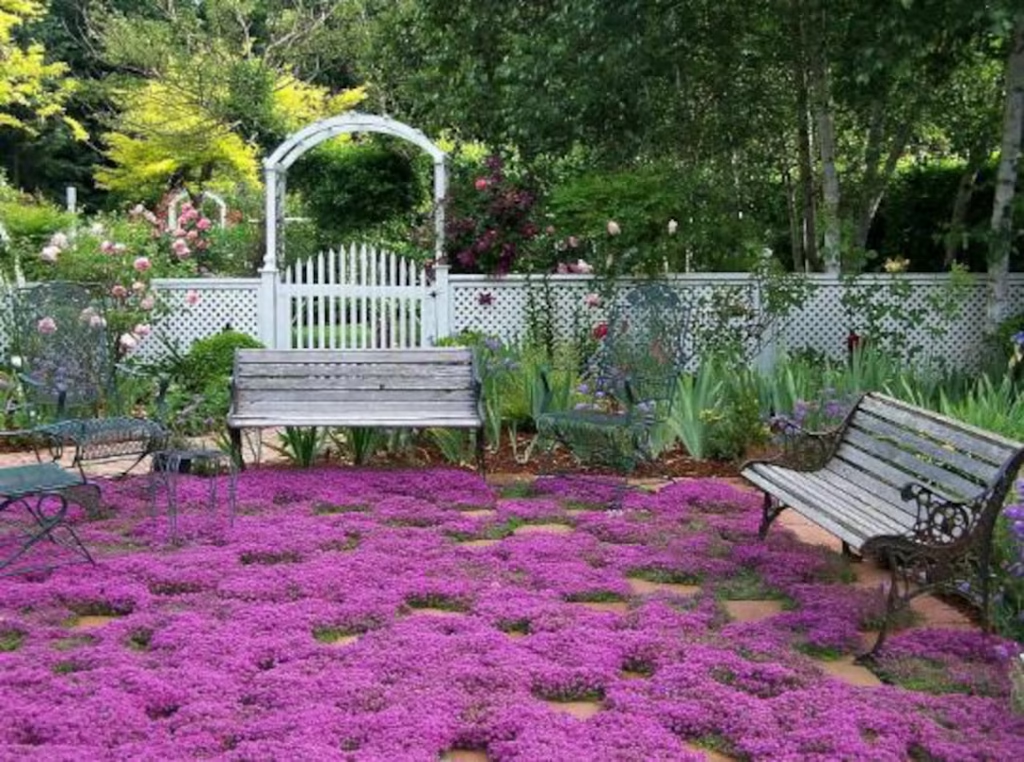
Creeping thyme is one of my favorite low-maintenance ground covers because it checks so many boxes at once. It spreads quickly to cover open spaces, but it stays low enough to look tidy and intentional. The best part is the soft fragrance that drifts up whenever you brush against it.
It thrives in sunny spots and once it’s settled in, it barely needs extra water. I’ve used it between stepping stones, and it creates a natural, rustic feel while preventing weeds from popping up. Unlike traditional grass, it doesn’t mind the heat and can survive long dry spells without looking stressed.
In the summer, tiny purple blooms blanket the thyme, turning ordinary patches into a pollinator hotspot. Bees absolutely love it, and I find it rewarding to see life buzzing around the yard. It’s not only practical but also gives your outdoor space a sensory element—sight, scent, and even sound.
2. Sedum (Stonecrop)
Sedum is a true champion when it comes to handling tough conditions. These succulents come in a wide range of shapes and sizes, from tiny ground-hugging mats to upright clusters. I especially love their fleshy leaves, which store water and keep them thriving even when the soil dries out completely.
What makes sedum shine in the front yard is its ability to adapt. It can handle poor soil, full sun, and weeks without rain. I’ve seen it thrive in rock gardens and sloped areas where grass would never survive. Plus, sedum varieties come in so many colors—from soft greens to reds and golds—that you can really play with design.
Late in the season, many types of sedum produce clusters of star-shaped flowers. They attract butterflies and other beneficial insects, adding even more life to the garden. Because it’s evergreen in many climates, sedum ensures your yard looks neat and vibrant all year.
3. Ice Plant (Delosperma)

Ice plant is one of those ground covers that demands attention. Its bright, daisy-like flowers appear in bold shades of pink, orange, or purple, often covering the plant so completely you can barely see the foliage beneath. In a front yard, this kind of color impact makes a big statement.
It’s well-suited to hot, dry spots because it thrives in sandy, well-drained soil. Once it gets established, it hardly needs extra watering. I’ve seen ice plant used on slopes to prevent erosion, and the way it cascades and fills space is both functional and beautiful.
Aside from the flowers, the succulent foliage has a shimmering quality, almost like it’s dusted with frost—hence the name “ice plant.” That subtle sparkle adds texture even when it’s not in bloom. If you want a low-water ground cover that doubles as a conversation starter, this one fits the bill.
4. Creeping Jenny (Lysimachia nummularia)
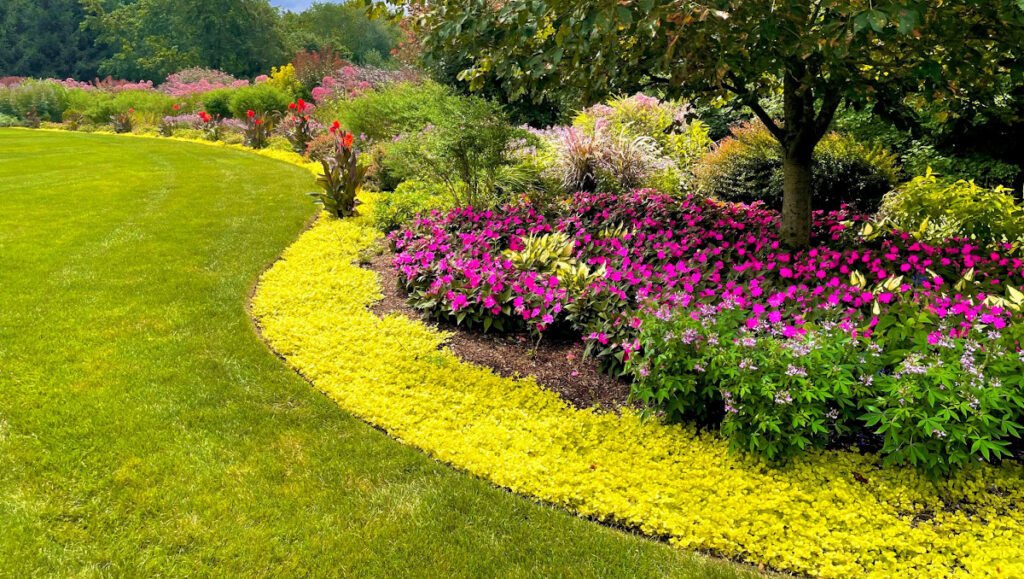
Creeping Jenny is a quick spreader with vibrant golden-green foliage that instantly brightens shady or sunny spots. Its round leaves form a dense mat that softens edges around walkways, rocks, or borders. When the sunlight hits it just right, the color really pops and draws the eye.
While it prefers regular watering, Creeping Jenny can tolerate dry conditions once it’s mature. I’ve seen it survive through drought periods with just a little supplemental water here and there. Its resilience makes it a good option for areas where you want dependable ground coverage without constant babysitting.
One of the fun things about Creeping Jenny is how versatile it is. It works well spilling over retaining walls, filling cracks, or softening the look of hardscapes. Instead of struggling to keep grass alive in tricky areas, this plant adds personality and brightness without much effort.
5. Lantana

Lantana brings bold color and toughness together in a way few plants can. Its clusters of tiny flowers change shades as they mature, giving you a multi-toned effect on a single plant. The blooms last from spring through fall, ensuring that your front yard never looks dull.
This plant thrives in heat and dry conditions, making it a reliable choice for drought-prone yards. I’ve seen lantana practically glow in the sun while other plants wilted. Once it’s rooted in, it requires very little water to stay happy.
Butterflies and bees adore lantana, so if you’re aiming for a pollinator-friendly yard, this is a must-have. The spreading growth habit makes it a perfect ground cover for open spaces, and in warmer climates, it even acts as a perennial, coming back stronger each year.
6. Blue Star Creeper (Isotoma fluviatilis)
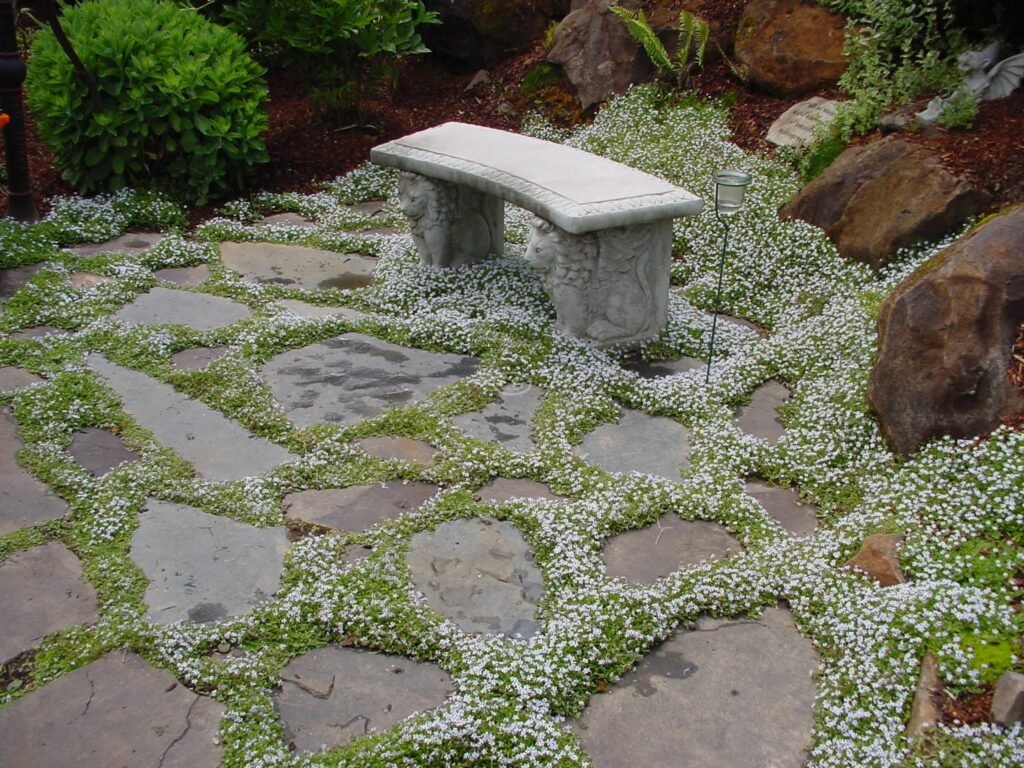
Blue Star Creeper is a charming ground cover that looks delicate but can handle tough conditions. Its tiny blue flowers look like little stars scattered across the yard, softening walkways and adding a magical touch to plain patches.
It’s drought-tolerant once it’s established, and it grows densely enough to suppress weeds. I’ve used it in areas where a traditional lawn would struggle, and it not only filled in quickly but also gave the yard a cozy, cottage-like feel.
Because it’s low-growing and tolerant of light foot traffic, Blue Star Creeper works beautifully between pavers or stones. It feels like a living carpet underfoot, and unlike grass, it doesn’t demand constant mowing or watering to look good.
7. Yarrow (Achillea millefolium)

Yarrow is often underestimated, but it’s one of the most resilient ground covers you can plant. With its fern-like foliage and clusters of flowers in colors like yellow, white, pink, and red, it brings texture and vibrancy to the front yard.
This plant is highly drought-tolerant and thrives in poor soil. I’ve seen yarrow flourish in spots where nothing else wanted to grow, and once it’s established, it basically takes care of itself. The only time I’ve ever had to intervene was trimming it back when it spread too far.
The flowers are a big bonus—they last a long time and attract bees, butterflies, and even hummingbirds. Yarrow also makes a lovely cut flower, so it’s one of those plants that adds beauty outdoors and indoors.
8. Woolly Thyme

Woolly thyme is as charming as it sounds, with soft, silvery leaves that create a velvety mat across the ground. It’s especially striking when paired with rocks or gravel, where its unusual texture really shines.
Like other thyme varieties, it’s very drought-tolerant and requires minimal care once planted. I love how it thrives in sandy or rocky soils that would frustrate other plants. Even during dry summers, it keeps its soft appearance without turning crispy.
In summer, small pink flowers appear, adding a splash of color and attracting pollinators. But honestly, the foliage alone is reason enough to grow it—it adds a calming, almost whimsical quality to any landscape.
9. Portulaca (Moss Rose)
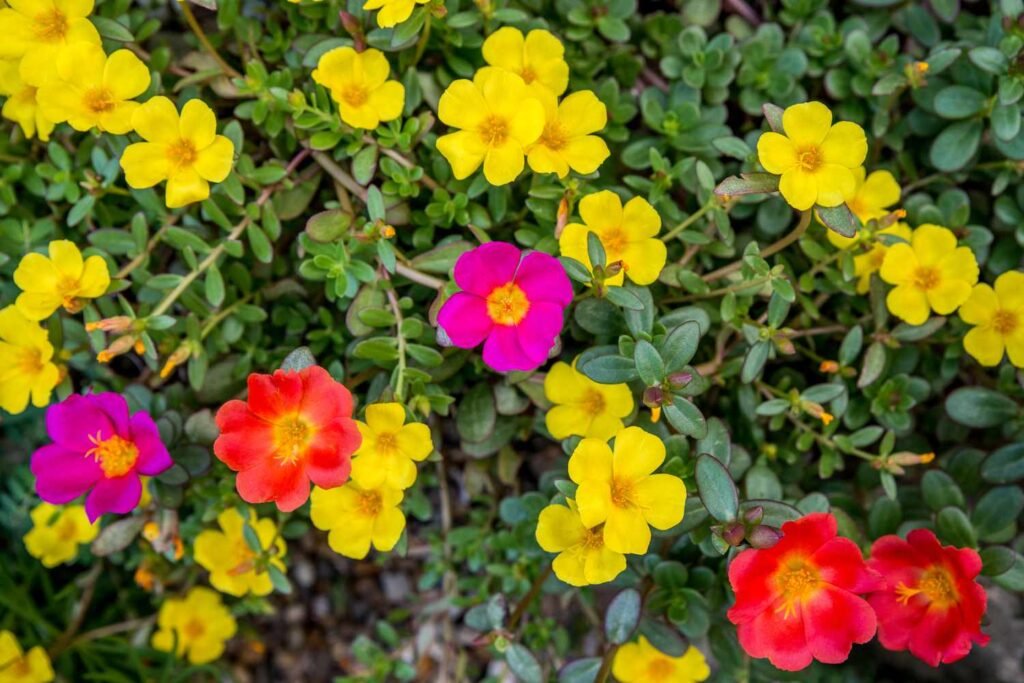
Portulaca is one of those ground covers that feels joyful. Its blooms open in the morning sun and come in a dazzling array of colors, from hot pinks to sunny yellows. The succulent-like foliage is just as interesting, with fleshy, needle-shaped leaves that hold onto water.
This plant thrives in hot, dry soil and actually prefers neglect. I’ve planted it in spots where little else survived, and it transformed them into cheerful, blooming carpets. It’s especially handy for filling tricky edges around driveways or walkways.
Though it’s an annual in many regions, portulaca reseeds itself readily, so you may find it returning year after year without extra effort. It’s the kind of plant that rewards you with color and personality while asking for almost nothing in return.
10. Ajuga (Bugleweed)
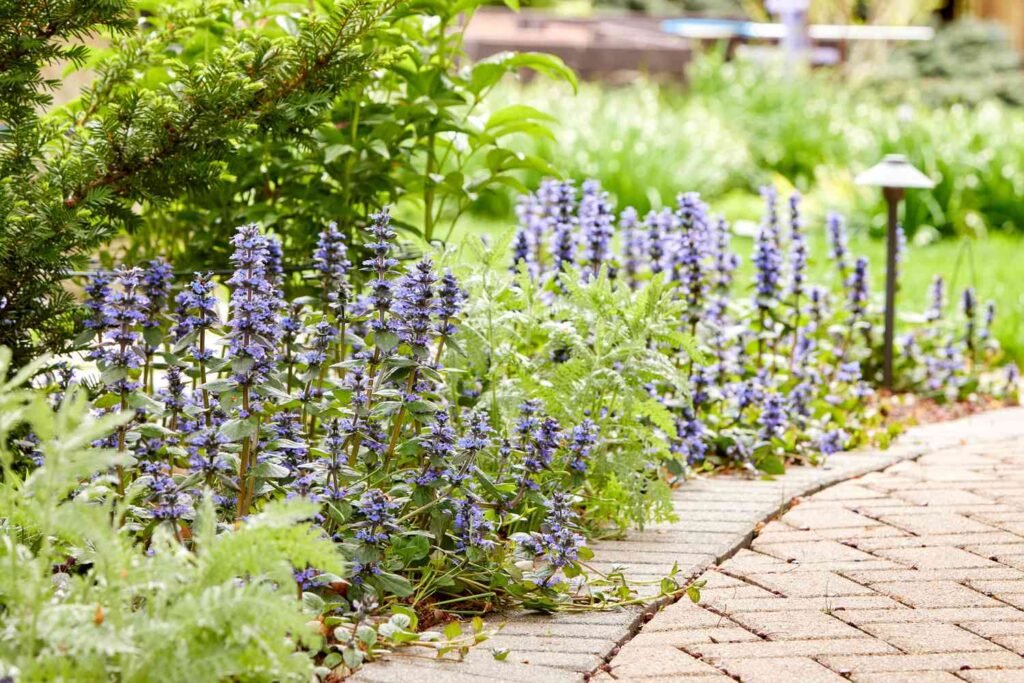
Ajuga is a ground cover that offers both colorful foliage and beautiful blooms. Its leaves range from deep green to bronze and even shades of purple, giving it a rich, layered look. In spring, it sends up spikes of blue flowers that contrast beautifully with the dark foliage.
It’s surprisingly drought-tolerant once it’s settled in, though it appreciates occasional watering during extended dry spells. I like using it under shrubs and trees where grass refuses to grow, and it spreads fast enough to cover bare soil without much help.
Because of its bold leaf color, ajuga works well as a living accent. Instead of just covering ground, it creates visual interest throughout the year, making it one of those plants that does double duty in the landscape.
11. Gazania (Treasure Flower)
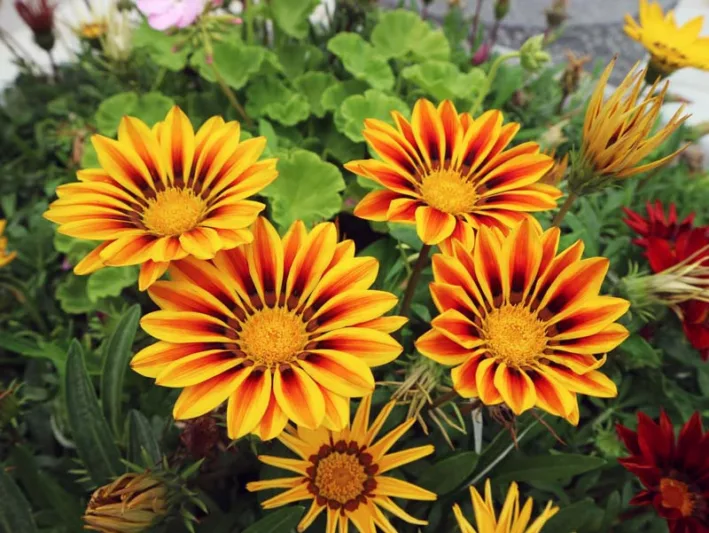
Gazania is another daisy-like bloomer that thrives in hot, dry climates. Its flowers come in striking shades of orange, yellow, red, and pink, often with dark, dramatic centers. What makes it especially fun is how the blooms close at night and reopen in the sun.
This plant handles poor, sandy soil with ease and doesn’t need much water once established. I’ve seen gazanias thrive in roadside plantings where other flowers wouldn’t stand a chance. They’re tough but never look tough—they bring brightness to some of the harshest spots.
Because it forms a low, spreading mat, gazania works beautifully as a drought-tolerant ground cover for open spaces. It’s one of those plants that gives a constant summer vibe, no matter the season.
12. California Poppy (Eschscholzia californica)

California poppies bring a wild, meadow-like charm to the front yard. Their iconic orange blooms are cheerful and bold, swaying gracefully in the breeze. I’ve always loved how they self-seed, creating natural drifts of color year after year.
They’re incredibly drought-tolerant and thrive in sandy, rocky, or otherwise “poor” soil. Once planted, they need almost no attention, which makes them perfect for low-maintenance landscaping. The more sun they get, the better they perform.
Beyond their beauty, California poppies have a timeless, natural look that feels effortless. If you want your front yard to look like it belongs in a sun-soaked field, these flowers are the way to go.
13. Clover (Microclover or White Clover)
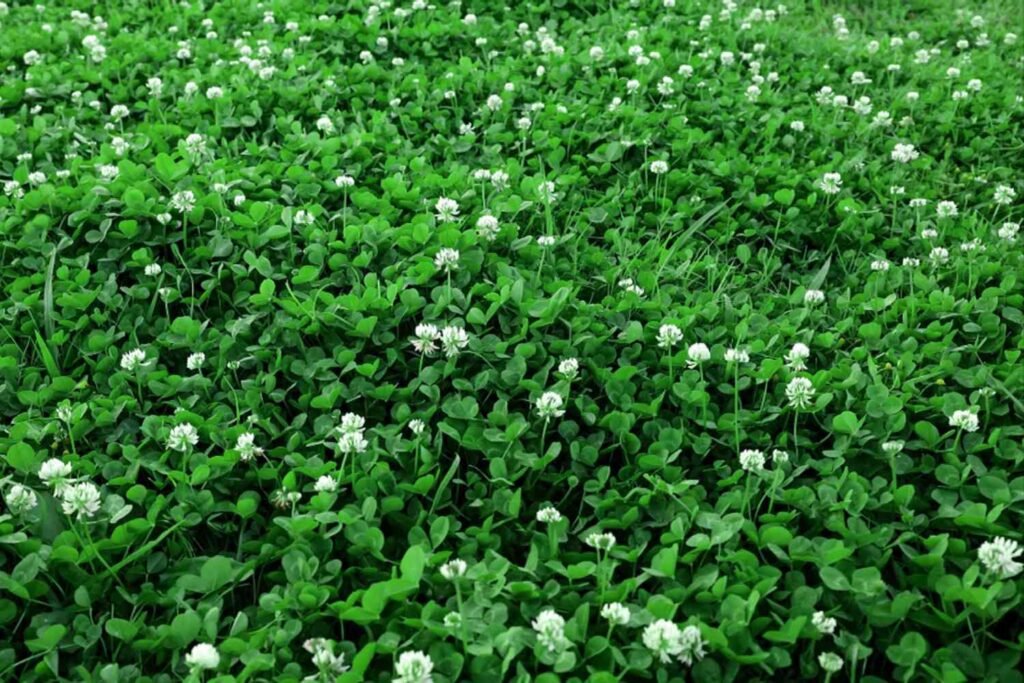
Clover is becoming a popular alternative to traditional lawns, and for good reason. It creates a soft, lush carpet of green that looks good without constant watering or mowing. Unlike grass, it stays vibrant even during dry periods.
What sets clover apart is its ability to fix nitrogen in the soil, naturally improving its fertility. That means it not only thrives itself but also benefits neighboring plants. I’ve noticed that it stays green longer into the season than grass and needs almost no care.
Microclover, in particular, stays low and neat, making it ideal for front yards. It handles light foot traffic and gives you a lawn-like appearance without the water-hungry maintenance. It’s a smart, eco-friendly swap for anyone wanting a greener look without the guilt.
Tips for Choosing the Right Ground Cover
When picking a ground cover, it helps to match the plant to your yard’s conditions. Sun-loving plants like lantana and gazania won’t thrive in shade, while options like ajuga and creeping jenny can brighten dim spots.
Maintenance is another factor—fast spreaders can fill space quickly but may need trimming to stay neat. Think about how much effort you want to put into shaping or containing your plants.
Lastly, consider the look you want. Do you prefer a carpet of evergreen foliage, or are bursts of seasonal flowers more your style? Mixing and matching different ground covers can give you a layered, dynamic front yard that evolves with the seasons.
Final Thoughts
Drought doesn’t have to mean a dull or lifeless front yard. With the right ground covers, you can create a vibrant, water-wise landscape that thrives with minimal care. Each of these plants offers its own blend of toughness and beauty, proving that low-maintenance can still mean high-impact design.
When I started swapping grass for ground covers, I expected to lose that lush look, but the opposite happened—my yard became more colorful, more diverse, and far more inviting. Choosing plants that work with the climate instead of against it makes the yard feel effortless and sustainable.
So if you’re ready to rethink your front yard, try adding a few of these drought-tolerant ground covers. They’ll save you time, water, and frustration, all while turning your outdoor space into something uniquely yours.

